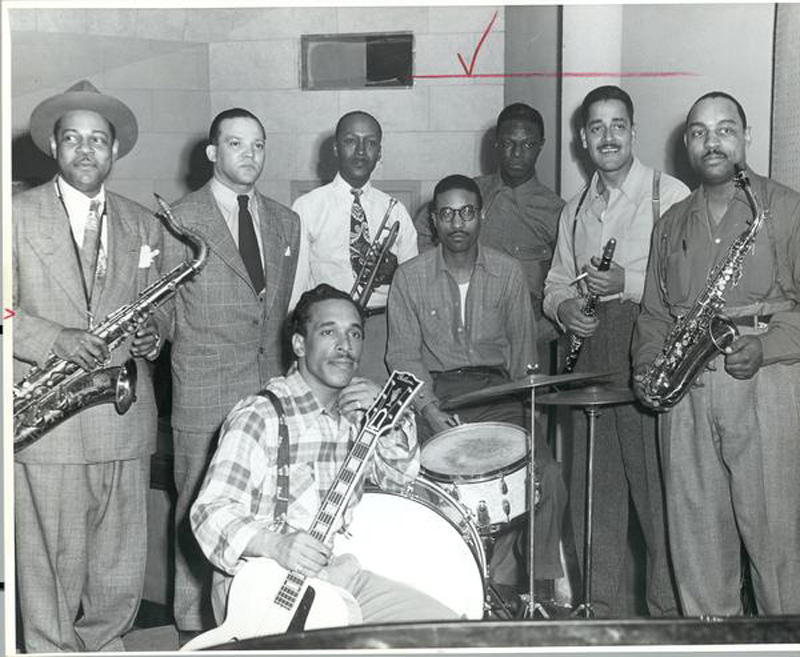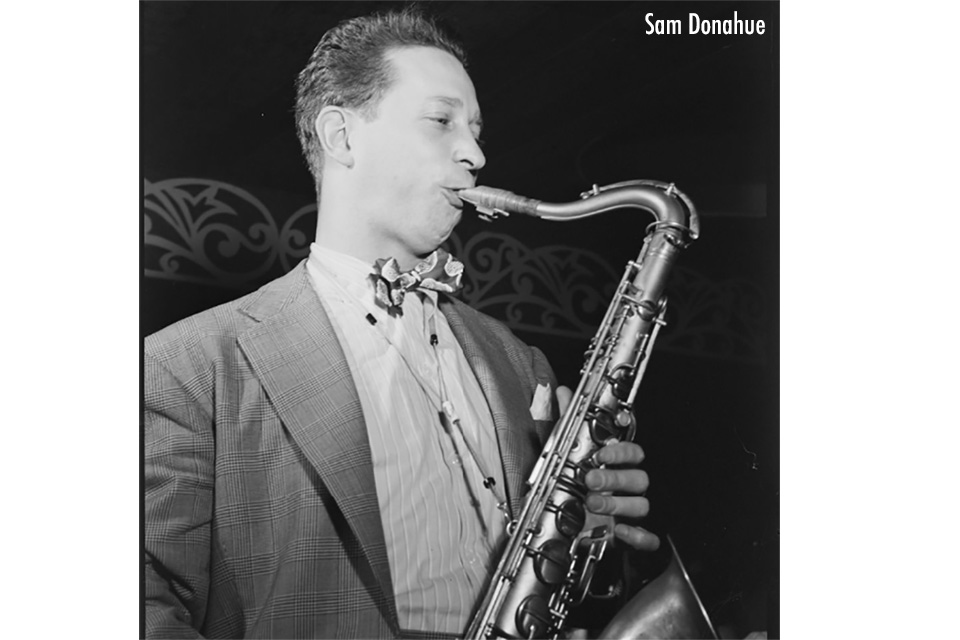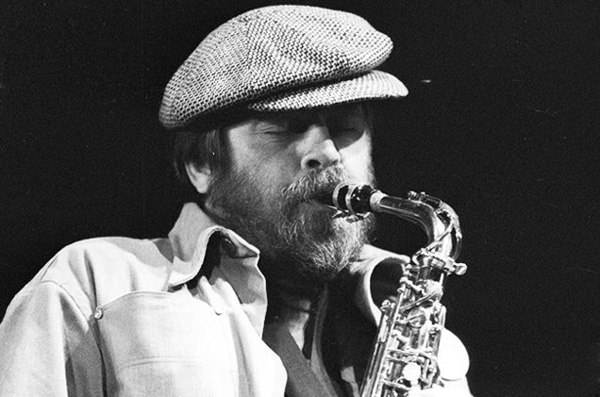Eight Men, a Young Woman and a Studio
20th October 2022Peter Gardner
According to one source the group was called ‘Dave Dexter’s International Jazzmen’, whereas, more accurately, the group’s name was ‘Capitol’s International Jazzmen’. Dave Dexter was involved; he was Capitol Records’ producer and he had assembled the musicians, but the group didn’t bear his name. ‘Capitol’ was the label they were recording for and as for ‘International’, this apparently came from the fact that three of the musicians had enjoyed longish spells in Europe. And the seeming grandeur of the title was certainly deserved: the group consisted of Coleman Hawkins, tenor sax, Benny Carter, alto sax and arranger, Buster Bailey, clarinet, Bill Coleman, trumpet, Nat King Cole, piano, Oscar Moore, guitar, John Kirby, bass, and Max Roach, drums.
Even bearing in mind that only Roach would count as a modernist, this must still stand as one of the very best octets one could get together in March 1945. ”Capitol”, according to Benny Carter’s biographers, had taken “advantage of the presence in Los Angeles of this dream personnel”, musicians from several backgrounds all on the West Coast. They would record only once together.

Sam’s Liberation Band
20th January 2022“…he took over Artie Shaw’s band after the latter’s discharge and developed it into one of the most magnificent bands of all time.”
George T.Simon
Late in 1943 a twenty-five year-old musician went to Washington with a mission. The future of his band was uncertain. Maybe he could persuade the admirals his band should keep on playing. He was Sam Donahue and, fortunately, he was successful.

…and then came Phil and Lew
6th December 2019The musical revue, ‘A to Z’, opened on 11th October, 1921, at the Prince of Wales’ Theatre in London’s West End. It would run for 428 performances. Ivor Novello is credited as being the composer of ‘A to Z’, though other songwriters contributed pieces of their own, including the revue’s most durable song. Composed by Philip Braham with words by Douglas Furber, ‘Limehouse Blues’ would become something of a jazz standard or, if you have grown tired of musicians battling over its accommodating changes at breakneck speeds, maybe you would prefer the description ‘jazz warhorse’. Recorded by Paul Whiteman in the early 1920s and, several decades later, by the Sun Ra Arkestra, ‘Limehouse Blues’ certainly has staying power. It has also proved quite enticing to post-bop saxophonists wanting to give their awesome techniques a workout while providing their rhythm sections with a wake-up call. But more of them later.

“Faz” by Peter Gardner
9th March 2018The number of great clarinet players who were born or learned to play in New Orleans when jazz was in its infancy is quite amazing. Johnny Dodds, Edmond Hall, Albert Nicholas, Omer Simeon, Leon Roppolo, Jimmy Noone, Barney Bigard, Sidney Bechet and Irving Henry Prestopnik are just some that come to mind. If the last of these is not too familiar, maybe you know him under the Mediterranean name for ‘beans’, possibly acquired as a term of commendation, or because in his early days he only played from music in a prim and proper or ‘fah-so-lah’ kind of way. Still, whatever its etymology, ‘Fazola’ replaced the east European name of his father, ‘Henry’ was dropped and for most of his adult life he was known as Irving Fazola or ‘Faz’.
The Fastest Tenor in the West
17th January 2018He was a seventeen year-old alto saxophone player when he first joined Lionel Hampton’s band in 1945, but Gladys Hampton, Lionel’s wife, who also managed Lionel’s band, insisted that the teenager with the alto had been hired to play tenor saxophone, and no one argued with Gladys. So, Johnny Griffin started to play tenor. Before too long he was duetting with the band’s star tenor player, Arnett Cobb. Eventually the routine of playing Hampton’s big hits night after night became tiresome. Griffin left Hampton’s band, and, though he returned for a brief spell, he finally quit for good shortly after his nineteenth birthday.
Artie Shaw – The Last, the Very Last, the Final Gramercies
8th December 2017Join jazz aficionado Peter Gardner as he discusses the excellent late recording work of clarinettist Artie Shaw…
It wasn’t until about twenty years ago that I realised that such marvellous recordings existed. I was in a large bookshop in the north of England and I had been told the bookshop also stocked some jazz CDs. As I recall, there weren’t too many jazz CDs there and most seemed to be by John Coltrane and Miles Davis. But somewhere near the end of the jazz shelves, perhaps between Rollins and Tatum, I came across a double CD whose attention-grabbing title had the words ‘…The Last Recordings Rare and Unreleased’.
The First Great Jazz Saxophonist
3rd November 2017“Sidney Bechet was, by an impressive margin of several years, the first great jazz saxophonist.”
– Humphrey Lyttelton
One day in 1920 a trumpeter in his very early twenties and a clarinettist, who may not have been much older, were walking down London’s Wardour Street. The trumpeter had been born in the West Indies, but had spent most of his early years in South Carolina. The clarinettist, who had toured with various groups since a teenager, was originally from New Orleans. He was a Creole; most of his forbears were African Americans, but at least one was French. Both the trumpeter and the clarinettist had come to England from America with Will Marion Cook’s Southern Syncopated Orchestra in 1919. In the window of J. R. Lafleur’s music shop at 147 Wardour Street the clarinettist spotted a shiny straight soprano saxophone.
‘Ronnie Peters’, ‘Buckshot La Funke’, Julian ‘Cannonball’…
8th September 2017Join jazz aficionado Peter Gardner with his look back at the one and only Julian ‘Cannonball’ Adderley…
Some accounts of his arrival on the New York jazz scene read like an exaggerated piece of jazz folklore. Aged twenty-six, already a successful high school music teacher, he was in New York with a view to starting graduate studies to add to his already impressive educational CV. On Saturday 19th June, 1955, he had his alto with him and rather than leave it in a car, which could be fraught with danger in New York, he took it with him into Café Bohemia to hear a group led by bassist Oscar Pettiford. Pettiford’s tenor player, Jerome Richardson, hadn’t shown up and neither had his dep.
Not ‘The Lion’ and Hamp in Pasadena
18th July 2017Join jazz aficionado Peter Gardner with his look back at one of the premier, but lesser known, lead Alto Saxophonists in jazz history…
If your CV included playing lead alto in the bands of Jimmie Lunceford, Harry James, Duke Ellington, Billy May and Charlie Barnet as well as spells with Jazz at the Philharmonic and Gene Krupa trios, and you had played on one of the most famous jazz records, we might expect that you would be quite well known to any modern saxophonist who has more than a passing interest in the history of jazz and big bands. Sadly this is not the case, and when you mention this saxophonist’s name, people with some knowledge of jazz history often think you are talking about a famous stride pianist. So, let me clarify. Willie Smith, or to give him his full name, William McLeish Smith, was the lead alto saxophonist with the more than impressive CV. Willie ‘The Lion’ Smith was a justifiably famous, bowler-hatted, cigar-chomping, extrovert stride pianist.
Benny’s Tales
19th April 2017Join Jazz aficionado Peter Gardner as he explores the great Benny Goodman…
It has become part of jazz folklore that once upon a time in a Chicago slum, shortly after the end of the First World War, a desperately poor Jewish father, who had emigrated to America from Eastern Europe, decided that some of his children might benefit from learning to play musical instruments. On hearing that a nearby synagogue ran a band for boys, the father took three of his twelve children to meet the synagogue’s band master.
A Forgotten Man?
24th March 2017by Peter Gardner
In the UK his name rarely crops up in discussions about jazz saxophonists and no saxophone student I have talked to recently has ever heard of him. I suspect the same goes for many of those students’ teachers as well. Even if you look on the websites of the famous jazz stars he played and recorded with, his name is at best infrequent.
Barrow to Broadway: a White Christmas Story by Peter Gardner
7th December 2016On Tuesday 11th March 1879 The Barrow Herald, one of the local papers for Barrow-in-Furness in the north west of England, reported that on the previous day a vessel had been launched by the Barrow Shipbuilding Company and that “Miss Welch, daughter of the American minister in London, gracefully performed the ceremony of naming the vessel, the launch being of the most successful character.”
‘Big Ben’ by Peter Gardner
3rd November 2016In January 1967 Ben Webster was playing a short season at Ronnie Scott’s Cub in London. As often happened back then, star soloists who were playing at Ronnie Scott’s would play some out of town gigs. That was how, a few months earlier, I had heard Johnny Griffin in Coventry’s Leofric Hotel. Griffin, ‘The Little Giant’, ‘The Fastest Tenor in the West’, had left his audience enthralled and somewhat drained by his astonishing speed, unquenchable imagination and stamina.
Benny Carter: ‘The King’
11th October 2016…he is a king, man! You got Duke Ellington, Count Basie, and my man the Earl
of Hines, right? Well, Benny’s right up there with all them cats. Everybody
that knows who he is call him King! He is a King!
Louis Armstrong
Generations of jazz fans grew up in the firm belief that the three greatest alto saxophone players were Johnny Hodges, Benny Carter and Charlie Parker. Of this wondrous trio, only one could claim to be multi-talented; he was Benny Carter. His principal instruments were the alto sax and trumpet, which prompted someone with the pen-name of Snooty McSiegle to wax poetic:
The Shy Revolutionary
22nd September 2016Join Jazz aficionado Peter Gardner as he takes a look at the glorious Lester Young…
By the autumn of 1936 someone who would become one the most influential and imitated of all jazz musicians had been ‘on the road’ for most of his twenty seven years, but hadn’t yet been heard on record. Lester Willis Young had started out as a boy drummer in his father’s band, though in early adolescence he discovered that by the time he had packed up his drums at the end of an evening, the girls had gone. So, he switched to saxophone.
The Making of a Masterpiece…
16th August 2016Join Jazz aficionado Peter Gardner as this time he takes a look at the origins of ‘Body and Soul’…
It would become one of the world’s most recorded songs. One recorded performance would reach artistic heights rarely exceeded in the history of jazz. As the result of that performance, the tune would become something of a test piece for jazz musicians, particularly tenor saxophonists. Yet, some accounts of the song’s origins give little hint of the memorable things that were to follow.
When Johnny Hodges Doubled…
10th June 2016Join Jazz aficionado Peter Gardner as he takes us back to 1938 & that famous Carnegie Hall Concert with many of the Jazz greats…
On the evening of 16th January, 1938, Benny Goodman and His Orchestra played before a packed house at New York’s Carnegie Hall. Billed as ‘The First Swing Concert in the History of Carnegie Hall’, it was not the first time jazz had been played in what Down Beat called the “sanctum of long-hairs”, but it was the first time an entire Carnegie concert had been devoted to such music.
Stan Getz: Delving back…
9th May 2016Join Jazz aficionado Peter Gardner as he delves back into the family history of Stan Getz, one of the very greatest Jazz Saxophonists…
When The Observer’s jazz critic Benny Green heard Stan Getz playing at Ronnie Scott’s Club in March 1971 he spoke of Getz as “one of the greatest jazz masters of all time” and he added: “It is doubtful if Getz has ever played better in his life…Getz’s genius has flowered again”.
UK Jazz History…
17th March 2016Preface: I have spoken to Peter for many years via telephone whilst working for Dawkes. Throughout that time he has regaled me with his jazz related historical stories and teachings. In fact, in preparing to give jazz related talks in the North West he’s often sent me a copy of the talk with accompanying CD. I felt it was time for some of these fascinating stories to be re-told to our customers, for its on these building blocks that the current genre of jazz in the UK was born…Sam @ Dawkes.